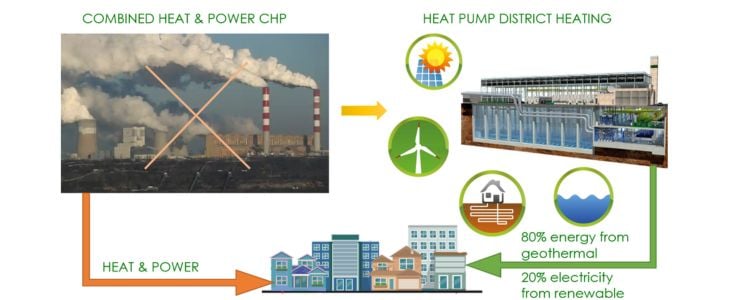The story of district heating in Denmark is one in which a combination of regulation and thoughtful planning have meant a giant leap forward towards the energy transition.
As such, the country has managed to successfully move away from fossil fuels while, at the same time, becoming one of the best countries in the world in terms of energy security, equity and sustainability.
This success can be partially described by citing some noteworthy figures released by the Danish Energy Agency: approximately two thirds of Danish households are now connected to a district heating structure; and more than half district heating systems in Denmark are based on renewable energy sources.
From its first heating supply law in 1979 to today’s success, let’s have a look at the particularities of district heating in Denmark and how the country became a global leader in District Heating.
District heating in Denmark: the characteristics
Looking at the figures above, it’s no question Denmark has made a bold commitment towards achieving sustainability in heating.
While other countries lag behind in face of regulation targeting sustainability, heating in Denmark has taken a proactive attitude and expects to meet European Green Deal targets through using the heating systems of the future, today.
District heating in Denmark stands out for its ability to combine cutting-edge technology with renewable resources. This synergy has allowed for the efficient integration of systems such as large-scale heat pumps, solar thermal installations, and advanced thermal energy storage (TES). Thanks to this, Denmark not only ensures a reliable and resilient heat supply but also significantly reduces greenhouse gas emissions from its heating sector.
Key features of District Heating in Denmark
First and foremost, the country began moving away from fossil fuels decades ago, during the 1970s fossil fuel crisis. This gave the country a head start that also translated into fruitful and advanced schemes to develop district heating in Denmark.
As such, heating systems in Denmark have been part of major electrification efforts, many of which rely on outstandingly efficient industrial heat pumps.
Additionally, this approach has allowed to facilitate the quest for implementing renewable heat sources. From wind farms to solar power, district heating in Denmark is being able to materialize the renewable energy transition through a new generation of DH projects (the 5th generation). In fact, the expansion of large-scale solar heating in Denmark is particularly noteworthy: it’s estimated that by 2025 heat production from solar heating will amount to approximately 7 times the amount in 2015.

At the same time, a main focus has been developed to reuse heat as energy that would otherwise be wasted. A prime example of this is the common use of waste heat from power production.
Finally, every solution within the district heating in Denmark model takes into account the possibility for short-term heat storage. Thermal Energy Storage (TES) technology allows for the storage of thermal energy produced during off-peak hours for use during peak demand.
Finally, every solution within the district heating in Denmark model takes into account the possibility for short-term heat storage. TES technology allows for the storage of thermal energy produced during off-peak hours for use during peak demand.
This smart integration helps balance the grid, optimize resource consumption and reduce overall costs — all while ensuring maximum heat availability.
Regulation and planning for district heating in Denmark
The Heat Supply Act regulates district heating in Denmark, as well as any other initiative regarding heating. At the same time, while large CHP plants are regulated by the national electricity law, heating supply emanating from them is still regulated by the Heat Supply Act.
This regulation has set the characteristics and idiosyncrasy of district heating in Denmark, including the following:
- The principle guiding all heat planning initiatives is to promote the option that presents the most net benefits to society. This takes into account a socio economic cost-benefit analysis that evaluates all costs, including those affecting society and local communities. With environmental goals understood as major contributors to society, district energy along with cogeneration of heat an electricity have been promoted as key sustainability accelerators.
- It’s city councils, in cooperation with utility companies, that are responsible for heat planning in their respective municipal areas.
- The Danish Energy regulatory authority oversees every initiative within district heating in Denmark, in fact exerting a nationwide collective heat planning and monitoring.
- Fossil fuel taxes have been introduced for heat production, with an exemption for biomass.
Foreseeable trends in the district heating in Denmark
All signs point towards a hopeful future for district heating in Denmark. In fact, the Danish Energy Agency links the development of district heating in Denmark to meeting EU targets and ambitions running up until 2050 including being totally independent from fossil fuels by that time.

In order to meet these ambitious goals, a report by this public body has delineated the pieces of the puzzle that the future of heating in Denmark will consist of:
- An ever-increasing inclusion of renewable energies, with wind and solar energies taking center stage in the coming years. District heating systems paired with thermal storage technologies will guarantee the inherent intermittency of these energy resources to be successfully managed, and fluctuations managed. The incorporation of increasingly efficient industrial heat pumps will also play a key role in allowing heat generation from renewable sources.
- Low-temperature district heating systems are poised to become more important. Low temperature DH systems operate with supply temperatures of between 50°C and 70°C, which are significantly lower than the 80°C to 120°C (176°F to 248°F) used in conventional district heating systems. This reduction has allowed to minimize heat losses and, more importantly, enables the use of low-grade heat sources, including some key renewable sources. Advancements in 5th generation district heating are facilitating this crucial development.
Additionally, digitalization will become a core component in improving energy efficiency across DH networks. Smart meters, AI-driven demand forecasting, and automated control systems will allow for real-time monitoring and adjustments, enhancing both performance and user experience.
All in all, the outlook for district heating in Denmark reveals new opportunities for system optimization and energy efficiency await in an already advanced market.
The global leadership of Denmark in sustainable heating
Pushed by favorable public policies and long-term regulatory consistency, heating in Denmark will likely continue setting the pace globally for what a sustainable and scalable approach to heating looks like. With decades of experience and innovation, Denmark serves as a blueprint for other nations aiming to decarbonize their heating sectors while maintaining economic competitiveness and energy reliability.
As more and more households, commercial buildings, and public facilities connect to district heating (DH) systems, a virtuous cycle is being created. Technological developments in renewable energy integration, heat recovery, and thermal storage are continuously being tested and implemented in Denmark, making its energy infrastructure more resilient and future-proof.
Denmark’s leadership goes beyond implementation—it’s also about knowledge sharing and international collaboration. Danish expertise in district energy planning, low-temperature networks, and sustainable thermal engineering is increasingly in demand across Europe, Asia, and North America, where the urgency to reduce carbon emissions in urban environments is growing.
At Araner, we are fully aligned with this forward-looking vision. We’re committed to devising cutting-edge district heating systems that continue to push efficiency to the maximum, while keeping an eye on all efforts to minimize environmental impact.
Our engineering approach integrates solutions like thermal energy storage, industrial heat pumps, and smart distribution networks that adapt to our clients’ needs while supporting global climate goals.
Thanks to our decades-long experience in sustainable heating engineering, we’ve become a reliable partner for institutions, governments, and private companies aiming to lead in the energy transition.
Whether you are planning a new district heating project or looking to optimize an existing one, our team is ready to support your path toward a more efficient, sustainable energy future.
Learn more about our approach towards district heating by downloading our free District Heating ebook or get in touch with our team to learn how we can help you achieve your project’s needs.










